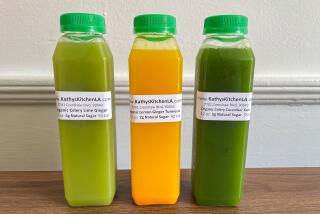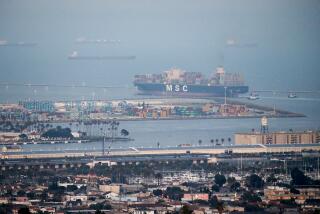Brazilian Juice Lands in the Big Orange
- Share via
At first telling, the story at the Port of Long Beach over the weekend seems of the coals-to-Newcastle variety--in this case, importing orange juice to the Big Orange.
Nonetheless, there at Berth 206 was the gleaming white hulk of the M.S. Orange Blossom, out of Santos, Brazil, pumping 1.2 million gallons of orange juice concentrate into stainless steel tankers for the final hauling to Sunkist Growers’ new “tank farm” at Ontario.
There, the Brazilian concentrate is blended with Sunkist’s own juice from its 6,000 California and Arizona growers. Then it is sold either in bulk form to the dairy trade for packaging or packaged directly for retailing under Sunkist’s label or under private labels for supermarkets.
20 Years of Brazilian Juice
The Brazil-to-Ontario bulk shipment technology is new with the Orange Blossom, but Sunkist has depended on Brazilian juice for blending for nearly 20 years, said Steve Richtman, the cooperative’s senior marketing manager for juice and beverages. Before the commissioning of the Orange Blossom and last June’s opening of Sunkist’s tank farm, concentrate was shipped in drums to the East Coast and trucked west--at significantly higher handling costs and a not insignificant loss in quality, Richtman said.
The new system keeps the 6-to-1 concentrate in slush form at 12 degrees from ship to tank until it is diluted to the 3-to-1 concentration used in retail sales. (This requires the consumer to add a volume of water three times that of the concentrate.) As the concentrate is pumped out of the ship’s stainless steel tanks and through 9-inch stainless steel pipes to feed four 500,000-gallon tankers simultaneously, nitrogen is pumped in to fill the void, reducing oxygen contamination.
The need for the Brazilian juice in this leading orange-growing region arises from the fact that Western growers concentrate on fresh fruit sales, Richtman explained. And the best eating orange has a higher acid level than the best juice orange. Florida, which produces most of the nation’s orange juice, harvests later than California growers do to reduce the acidity and increase sweetness.
“We bring in the Brazilian concentrate to meet a Florida sweetness standard that consumers expect,” Richtman said.
Brazil is now the world’s leading producer of orange juice, followed by Florida. In fact, the Orange Blossom’s owner, Sucocitrico Cutrale, also markets its own juice to U.S. industrial customers on the East Coast as well as servicing its Sunkist account.
Oversupplied Market
The current orange juice market is oversupplied and “very confused at this point,” Richtman said. Prices are running about half of what they were last year. More than ever, California growers will seek to sell as much of their crop as possible on the fresh fruit market rather than accept the far lower prices paid for orange products, including juice.
The Valencia Administrative Committee, which governs the shipment of fresh fruit to market under a federal marketing order, hopes to sell 54% of this year’s May-to-November crop as fresh fruit.
“Brazil’s production of frozen orange concentrate has risen dramatically in the past three years,” the committee reports in its 1986 marketing plan. From 175 million gallons in three years ago it soared to 250 million gallons last year and is expected to reach 286 million this year. “With increases of this magnitude, it would appear there will be continued downward pressures on returns from oranges utilized in products channels.”
Meanwhile, the new Ontario tank farm, which can hold 2.7 million gallons of concentrate, enables Sunkist to hold the slush in an oxygen-free environment until it is needed.
More to Read
Eat your way across L.A.
Get our weekly Tasting Notes newsletter for reviews, news and more.
You may occasionally receive promotional content from the Los Angeles Times.










